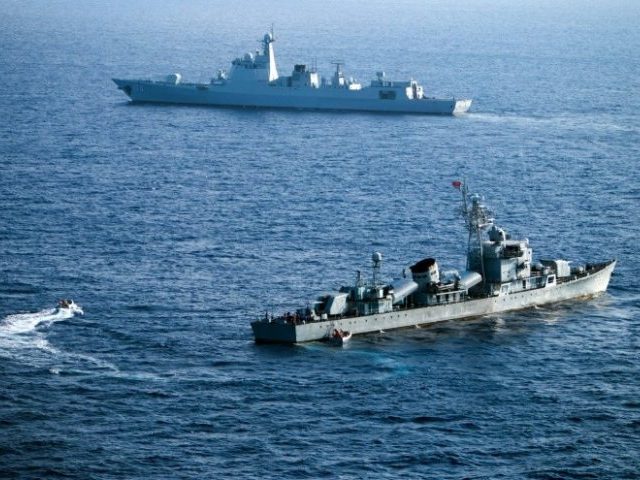China’s state-run Global Times announced on Tuesday that experts see potential for the illegally-constructed floating nuclear power plants in the South China Sea to provide technology that “could be applied to military nuclear vessels.”
The language in the article was deliberately vague, leaving unclear whether the Chinese mean to move nuclear vessels into the space they have illegally colonized in the South China Sea to allow access to these plants, or whether Beijing will begin constructing similar nuclear power plants on the mainland to use for military assets there.
China has repeatedly claimed that its constructions on artificial islands in the Spratly and Paracel Islands—sovereign territory of Vietnam and the Philippines—are for civilian use only while flooding the area with fighter jets, surface-to-air missiles, and other military technology.
“The primary focus of China’s offshore nuclear platforms—reportedly to be commissioned before 2020—will be for civil use on islands in waters such as the South China Sea, and as the technology matures, it could be applied to military nuclear vessels, Chinese analysts said,” the Times asserted. Citing “military expert” Song Zhongping, the Global Times said that it may be possible to create miniaturized versions of “the nuclear reactor-related technology” being installed in the Paracel Islands and use it with “the country’s military vessels, including nuclear-powered aircraft carriers or next generation nuclear submarines.”
Song did not elaborate on whether that meant using the reactors in the South China Sea—which would require transporting those military vessels there—or building them elsewhere.
The Global Times goes on to describe the technology in question, a “marine nuclear power platform” that has both floating and submersible modes and will “focus on solving power supply issues in the Xisha [Paracel] Islands and other islands in the South China Sea where infrastructure construction is underway,” Song said.
Construction on the prototypes is underway and the Times, citing Song, expects the first model to be commissioned before 2020.
Another expert, engineering academic Zhang Jinlin, described the plant as “a typical civilian-military integration project.”
The Chinese government has repeatedly referred to projects in the South China Sea in this way—intended for both civilian and military use, but allegedly installed without Beijing expecting to use them for military reasons.
China first announced the construction of floating nuclear power plants in the South China Sea in February. In addition to being one of the most lucrative trade routes in the world, the South China Sea is rich in oil and gas. Stable electricity in the region is pivotal for running exploration technology and develop resources there.
China claims almost the entire South China Sea, spanning territory disputed by Vietnam and the Philippines as well as Taiwan, Brunei, and Malaysia. Indonesian officials have also expressed alarm that China will encroach upon its territorial waters near Natuna Island.
In July 2016, the Permanent Court of Arbitration at the Hague declared China’s claims in the region illegal. The Chinese communist regime reacted by vowing to ignore the ruling and international law, and continue its colonization projects. Beijing asserts that the region has been Chinese “since ancient times,” a recurring phrase in the mouths of low-ranking officials and Xi Jinping alike.
Since then, China has continued constructing facilities in the Spratly and Paracel Islands. Last week, Chinese air force bombers conducted drills over the South China Sea.
Satellite images show that China has placed combat aircraft, “naval, air, radar, and defensive facilities,” “hardened shelters with retractable roofs,” advanced surveillance technology, and other assets in the region. Most of the information on these facilities comes from the Center for Strategic and International Studies, which regularly takes satellite photos of the area to analyze the progress of China’s construction there.

COMMENTS
Please let us know if you're having issues with commenting.